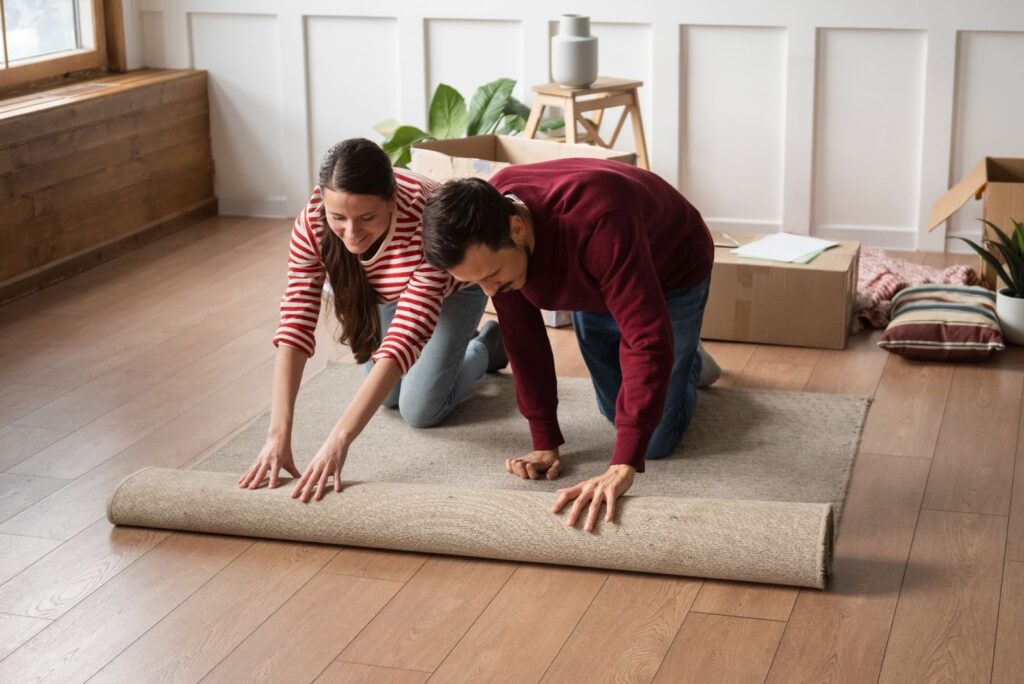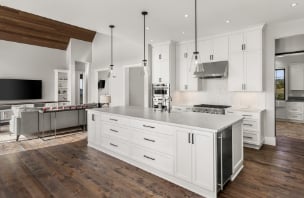

Flooring is the first thing your body meets every morning and the last thing you feel before you sleep; it sets the tone for how you move, breathe, and even think in a space.
It’s not about perfect minimalism or an austere aesthetic; it’s about designing with intent. Mindful design asks: does this surface invite me to pause? Does this texture reduce stress? Will this color make me feel lighter or more grounded? When you answer those questions with your floors in mind, you start building a home that nudges you toward wellness every time you step inside.
Flooring does a lot more than look pretty. It changes how a room sounds (soft floors quiet footsteps and chatter), how it feels (a cushioned floor can ease joint strain and invite barefoot movement), and how light and color read in the space (a warm tone can make a room feel cozy; a pale, matte finish can expand it).
Ready to turn your home into your calm zone? Let’s start from the ground up because the path to a more peaceful, restorative home really does begin beneath your feet.
How Does Flooring Affect Your Mind and Body?
We often think of wellness in terms of yoga mats, green smoothies, and deep breathing, but what about the surface you stand on every day? The truth is, the floor beneath your feet plays a quiet but powerful role in how your body and mind feel at home. It’s where comfort, calm, and design literally meet.
The Science of Comfort: Texture, Warmth, and Sound
Our brains respond instantly to sensory cues, especially touch, temperature, and sound. A soft or textured floor sends a signal of safety and comfort to the nervous system, lowering stress hormones and helping your body relax. In contrast, a hard, cold, or echoing surface can subtly keep you on alert, like your body’s always bracing for something.
That’s why texture matters more than we realize. Natural materials such as cork, wool, or bamboo feel inherently “alive.” Their slight give and organic variation ground us, creating a tactile connection that synthetic surfaces often miss. When your floor feels forgiving underfoot, your body releases tension and your mind follows.
Sound Absorption = Serenity
Noise is one of the biggest hidden stress triggers in modern homes. The sharper the echo, the more your body has to work to filter it out.
Soft flooring materials like cork, wool carpet, and even rubber act as natural sound sponges, soaking up excess noise and creating a hush that feels almost luxurious. That sense of quiet isn’t just nice; it’s restorative. Lower noise levels have been linked to better focus, lower heart rates, and improved sleep quality.
So yes, your flooring can literally quiet your mind.
The Sensory Effect of Walking Surfaces
Walking barefoot is one of the simplest mindfulness practices and a way to reconnect with the present moment through sensation. When your flooring invites that warm, slightly textured, and pleasant to touch, it becomes part of your self-care routine. Each step becomes grounding, reminding you of where you are and allowing your mind to slow down.
Also, have you ever noticed how stepping onto a warm floor in the morning feels instantly soothing, while a cold one makes you tense? Temperature has a direct line to the nervous system. Warm surfaces, especially natural ones like cork or engineered bamboo, help the body stay relaxed and improve circulation.
Cold tiles, on the other hand, can jolt your senses awake, which are great for a bathroom but not so much for a bedroom retreat.
The Best Natural Materials for a Calm Home
When it comes to creating a soothing, wellness-inspired home, few things compare to the grounding presence of natural materials. They feel better, age beautifully, and connect you to the earth beneath you. Synthetic options may mimic the look, but nothing beats the way organic floors breathe with your home, balancing comfort, texture, and peace.
Below are the natural flooring heroes that don’t just look stunning, they feel like wellness from the ground up.
Cork Flooring
Perfect for: bedrooms, meditation corners, or play areas where softness and silence matter.
If floors could meditate, they’d probably be made of cork. Soft, springy, and slightly warm to the touch, cork flooring has a subtle bounce that supports your joints and eases the impact of daily movement. It’s also naturally sound-absorbing, meaning fewer echoes and more serenity.
Beyond comfort, cork is hypoallergenic and antimicrobial which a quiet win for anyone sensitive to dust or indoor allergens. It’s sustainably harvested from bark (no trees are cut down), making it one of the most eco-gentle materials you can choose. Think of it as flooring that’s as kind to the planet as it is to your feet.
Wool Carpet
Perfect for: bedrooms, nurseries, or living rooms where warmth and tactile comfort are key.
There’s something undeniably comforting about wool. It’s plush, naturally insulating, and has that cozy texture that instantly makes a room feel safe and welcoming. Wool carpet doesn’t just look elegant, it feels like self-care.
Wool is also a natural temperature regulator, keeping your space warm in cooler months and breathable when it’s hot. Its natural lanolin coating helps repel dirt and moisture, so it’s easier to maintain than you might think.
Also, wool fibers are biodegradable and renewable, making this one of the most sustainable luxury choices out there.
Bamboo Flooring
Perfect for: open living areas, home offices, and spaces that crave a calm, uncluttered look.
Lightweight, durable, and beautifully zen, bamboo floorings totally bring a modern serenity that works in nearly any space. Culturally, bamboo has long been associated with balance, strength, and resilience, making it a meaningful choice for those designing with intention.
Eco-wise, bamboo grows astonishingly fast (up to an inch a day), making it one of the most renewable flooring materials available. It’s a win for minimalists, nature lovers, and anyone seeking to merge beauty with mindfulness.
How They Compare: Comfort, Sustainability, and Care
Not all eco-friendly or cozy flooring options are created equal. This quick guide compares comfort, environmental impact, and maintenance across three popular choices, helping you pick the material that feels right underfoot, aligns with your values, and fits your lifestyle.
| Material | Comfort Level | Eco-Footprint | Maintenance |
| Cork | Soft, cushioned | Excellent (renewable bark) | Easy, low upkeep |
| Wool Carpet | Plush and cozy | High (biodegradable, renewable) | Moderate (regular vacuuming) |
| Bamboo | Firm but warm | Excellent (fast-growing resource) | Easy, water-resistant finishes |
The Psychology of Color and Texture
You’ve probably felt it before, that instant sense of ease when you walk into a softly lit room with warm wood tones, or the quiet calm that comes from a muted, earthy palette. It’s not coincidence; it’s psychology.
The colors and textures beneath your feet send subtle cues to your brain, shaping how safe, grounded, and relaxed you feel in your own home.
The Psychology of Grounding
Our nervous system is deeply influenced by our surroundings, especially by what we touch. Flooring, being the most constant physical contact in a home, plays a silent but powerful role in regulating our stress response. Soft textures and warm hues lower tension and invite your body to relax. It’s the same reason you instinctively kick off your shoes after a long day; your body craves that sense of connection and relief.
This idea is part of what designers now call biophilic flooring, materials and tones that reconnect us with nature. These small, imperfect details remind the brain of natural rhythm and balance, encouraging presence and peace.
Color That Calms the Mind
Different tones trigger different emotional responses, and flooring color is no exception:
- Warm Neutrals = Cozy Calm
Beige, honey oak, and sand-colored floors bring warmth and familiarity, wrapping a space in quiet comfort.
This style is perfect for living areas or bedrooms where you want to feel instantly at ease. Warm neutrals are psychologically linked to comfort and security, that feeling of curling up under a blanket or sitting by a fireplace. They make large spaces feel intimate and bring a gentle sense of “home” to minimalist interiors.
- Warm Tones for Comfort & Coziness
Soft browns, golden honey, and muted ochres make rooms feel like a hug. Earthy floors read as familiar and reassuring, which is why they’re excellent in family rooms, bedrooms, and dining areas where comfort and lingering matter most. Warm tones pair beautifully with layered textiles and soft lighting to create a cocooning effect.
- Cool Tones for Serenity & Focus
Muted blues, slate grays, and soft greens bring a calming, focused energy. These colors mimic the sea and sky, lowering arousal and encouraging concentration, useful in home offices, meditation nooks, or bathrooms. Cool-toned floors can make a busy mind feel quieter and a cluttered room feel more spacious.
- Pop of Color: Is It Worth It?
Bold reds, corals, and tangerines can electrify a space, great for energizing a studio or accent zone, but they’re best used sparingly.
A colored runner, painted threshold, or a boldly dyed rug gives you the punchy feel without overstimulation. If you love color, pick one accent and repeat it subtly (a cushion, a lamp, a small art piece) so the floor stays a foundation, not a distraction.
- Soft Greens and Blues = Balance and Relaxation
Gentle greens and muted blues, like sage, seafoam, or gray-washed wood, evoke the tranquility of nature.
Studies in color psychology show that these tones lower heart rate and blood pressure, promoting calmness and mental clarity. When used in flooring, these shades visually cool a space and bring in an airy, spa-like energy that makes daily stress feel a little lighter.
- Natural Wood Tones = Grounding and Stability
The organic grains, knots, and warm undertones create a visual rhythm that’s deeply grounding. Walking across real wood or wood-look surfaces can subconsciously remind you of nature’s steadiness and simplicity. It’s the kind of subtle grounding that helps balance out our fast-paced, digital-heavy lifestyles.
Texture Therapy: Feel the Calm
The finish of your flooring matters just as much as its color. Matte and textured finishes like hand-scraped wood, cork, or looped wool absorbs light softly and add a tactile warmth that glossy or ultra-smooth surfaces lack.
Shiny floors might look sleek, but they often create glare and feel colder and more formal. In contrast, organic grains and matte textures encourage visual rest and comfort, helping your mind (and eyes) relax.
Your floors affect posture and joint stress more than you think. Surfaces with a bit of give (cork, wool carpet, cushioned underlayment beneath wood) absorb impact, reducing strain on ankles, knees, and hips. This matters especially if you stand a lot in the kitchen or work barefoot at home. Conversely, very hard surfaces—concrete or thin tiles without underlay—can accelerate fatigue.
Room-by-Room Guide to a Sensory Home
Designing a mindful home isn’t just about choosing beautiful materials, it’s about how each room feels when you step into it. Every space has its own rhythm, its own energy. The goal is to create a sensory flow throughout your home where textures, tones, and even scents work together to support calm and comfort.
Here’s how to bring that idea to life, one room at a time.
Bedroom
Start with the foundation: flooring that feels soft, warm, and soothing underfoot. Plush wool rugs or carpeting are ideal here. They’re naturally insulating, helping to maintain a cozy temperature while also absorbing sound (because nothing ruins serenity like echoing footsteps).
Opt for calming, earthy tones, like cream, oatmeal, or muted gray, and add tactile layers with natural fiber throws or a sheepskin rug beside the bed. When your feet meet warmth and softness first thing in the morning, it instantly sets a peaceful tone for your day.
Living Room
The living room is where life happens—conversations, laughter, and quiet nights in. To create a space that supports both connection and calm, look for flooring that balances comfort with durability. Cork and bamboo are standouts here.
Cork’s slight bounce and sound-absorbing qualities make it perfect for busy spaces, while bamboo brings a sleek, organic energy that keeps the room feeling open and light. Together, they create a sensory balance, quiet underfoot but visually warm.
Add soft furnishings and natural light, and you’ve got a living space that encourages relaxation without sacrificing style.
Dining Room
Dining rooms are where people gather to eat, talk, and slow down. The flooring here should mirror that energy: warm, inviting, and sturdy enough to stand up to daily life.
Engineered wood or bamboo flooring works beautifully, offering the natural warmth of wood with easier maintenance. Their subtle grain patterns add depth and character without overwhelming the space, which is perfect for cultivating focus and presence around the table.
For added comfort, consider a large woven jute or wool area rug beneath your dining set. It anchors the room, softens acoustics, and adds a tactile layer that complements shared meals and conversation.
Color matters here, too: mid-tone woods and honey hues evoke warmth and connection, while soft neutrals help keep the mood light and relaxed. Think “comfort meets elegance,” a space where every shared meal feels like a mindful moment.
Bathroom & Entryway
Natural stone or textured tiles are your best allies. They’re slip-resistant, durable, and full of organic beauty that instantly grounds the senses.
Stone brings a spa-like calm to bathrooms, especially when paired with neutral tones and soft lighting. In entryways, it signals a gentle welcome, helping you mentally shift from the outside world into your peaceful haven.
How to Design a Calm, Healing Space Beyond the Floors?
The floor sets the tone, but a truly restorative home is an orchestra of elements working together. Here’s how to make mindful flooring play nicely with the rest of your space.
Coordinating with Furniture & Decor
- Harmonious Pairings: Pair neutral bamboo flooring with a natural wood dining table for an uninterrupted warm flow. Let the tones be in the same family but vary the texture (smooth table, handwoven rug) to create visual interest.
- Contrast for Focus: Use a darker floor with light furniture to ground a room and create focal points. This contrast can help define zones in open-plan spaces.
- Layer Textures: Rugs, throws, and upholstered pieces should echo the floor’s texture language, soft floors pair with light linens; smooth wood floors benefit from nubby rugs for tactile contrast.
Wellness-Centered Room Rules
- Bedroom: Prioritize softness and sound absorption with a wool carpet or a thick rug with a plush pad. Use warm undertones and dimmable lights for pre-sleep rituals.
- Living Room: Choose materials that balance durability with comfort, such as cork or durable bamboo underfoot with throw rugs to define conversation areas.
- Home Office: A cool, focused floor (muted gray or soft green-toned wood) supports concentration. Add a cushioned chair mat if you use a rolling chair; it preserves posture and protects the floor.
- Entryway/Bathroom: Go practical and textural with honed stone or textured tiles that resist slips and help you transition mentally from outside to in.
Practical Tips for Intentional Design
- Match finish to function: matte finishes reduce glare and soothe the eye; they’re better for relaxation zones.
- Use rugs to create micro-environments: a soft rug under a reading chair can turn a corner into a sanctuary.
- Think in layers: color + texture + scent + light = a complete sensory experience. No single element should scream louder than the rest.
Final thought
Floors do more than hold up furniture, they hold up your day. When you choose tones and textures with intention and coordinate them thoughtfully with furniture, lighting, and scent, you build a home that supports how you want to feel: grounded, calm, and clear.
We can help you find floors that look great and feel great, making it easier to build a home we actually love living in.



